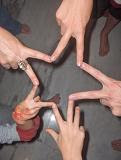We have been feeling the direct impact of the Indian democratic process in our mobile phones. Somehow, the mobile phones of everyone living in Andhra Pradesh end up in the hands of the political parties (hmmm, could it be bribery?) and we receive SMS messages from the main political parties. Here is an example
No job.... No money.... No hope. DO NOT LOSE HOPE. Bring back the leader. BRING BACK CHANDRABABU. THE leader who will make a difference in our lives. THE JOBLESS.

^ The Chandrababu in question is Chandrababu Naidu, a man who was central in the development of Hyderabad as a major city in the tech boom. He is famed for his trips to meet Bill Gates at Bill's home in Seattle and brokering a major development center for Microsoft here in Hyderabad. As of late, he is up to less dignified things - he is promising the poor of Andhra Pradesh color televisions if his party wins in the next elections. As a friend of mine noted - this is a sign of relative affluence increasing in India. He remembers a time when a bag of rice is what was offered for an electoral victory. One thing I have noticed is how many election posters in Urdu show Naidu with an Islamic skull cap (above). His name is recognizably Hindu. After looking into this, I found out that he is a Hindu, but reaches out to Muslims for votes. Think of Bill Clinton in a yarmukle (anyone else remember that?) and you'll get it.

^ Of note is that each party has election symbols (seen above) which allow illiterate voters to still recognize their party and cast a vote. In a country where many or most people are functionally illiterate, and those who can read often know entirely different languages and alphabets, it is useful to have a lotus flower (BJP) or a hand (Congress) to tell the masses who you are.

^ Some of the major characters in the recent election are a man named Advani. He was born in Lahore and his family was kicked out to India for being Hindus. He is a leaders of the Hindu nationalist BJP Party, which has many positive attributes, but it also seems to be a place from which Hindu bigotry occasionally emanates. In a worst-case scenario, the BJP is behind violence between communities. In reality, he is a very dignified man who speaks in India's defense in stark terms. After 26/11 (Mumbai attacks, transposed day/month is the Indian norm) he told it like it was and didn't hesitate to say what was going on. Looks like he was right.


^ Then there is the Congress Party, the party of Gandhiji and Nehru. It is a major source of power in India and has been for a long time. One person who is a leader, if not *the* leader of the Congress Party is Sonia Gandhi. She is the Italian wife of Rajiv Gandhi, who was killed a few decades back by a Sri Lankan terrorist. She has become Indian in most ways. She intrigues everyone here. She elicits very little animosity for being a foreigner here - except there is a guy named Modhi in Gujarat who said that she is part of a Christian conspiracy that has lead to various threats to Hindu identity, including suspiciously cross-shaped symbols on the back of the new two rupee coin (read more on this). This would seem silly, except Modhi and some like him have cranked up the rhetoric to the point that churches are being burned and Christians killed in various regions around India for evangelizing. But the real pain that Modhi has caused were the riots between Hindus and Muslims in Gujarat a few years back, about which he has no words of remorse or reconcilation.
So, it can be inspiring, humorous, complex and even a bit scary to see an Indian election proceed. Like everything else in India, it has more masala than its American counterpart. We in America have the two-men-in-navy-blue-suits thing time and again, complete with the obligatory Democratic candidate's visit to a black church and the Republican candidates visit to a farmer meeting in "the Heartland" where he wears a short sleeved business shirt. Well, maybe this last time was different. Yeah, I guess it really was.
So - we're having fun seeing an Indian election up close. May the best Party win.
